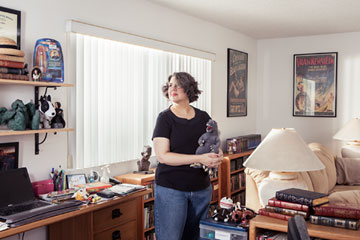
Myers, in her office in Fullerton, Calif., now writes books about the autism spectrum.
(3 of 4)
Not long ago I was walking through the United Airlines terminal in Chicago, which has a glass roof. I looked up, and in my mind I saw various images: the greenhouse at my university, the Crystal Palace from the 1851 World's Fair in London, a botanical garden. These structures weren't the same shape as the airline terminal, but they were all in my "glass roof" file.
Then I saw Biosphere 2 in my mind, and I noticed the turrets in its structure. They reminded me of the turrets on the Hoover Dam. So I started seeing pictures of turrets: on a castle in Germany, on the Disney Fantasyland Cinderella Castle, on a military tank.
At that point, I could have gone either way. I could have continued to root around in my glass-roof file, or I could have strayed into the turret file. To an outsider, my thoughts might appear random, but to me, I'm simply selecting which file folder I want to explore.
I've often said that my brain works like a search engine. If you ask me to think about a certain topic, my brain will generate a lot of hits. It can also easily make connections that will get off the original topic pretty fast and go pretty far afield.
Myers, the computer coder, reports a similar experience. At her first internship, her supervisor asked her to create a program in a coding language she'd never used before. To his astonishment, she finished in an hour. "I didn't need to know the language," she explains. To someone who's not skilled in associative thinking, she says, the challenge to write in a new language sounds like, "Oh, I have to learn a new thing." That kind of thinker sees only the differences among languages. Not Jennifer. She sees the similarities. As she says, "You're just putting new words on the old thing."
CREATIVE THINKING
I recently read a definition of creativity that made an impression on me: "a sudden, unexpected recognition of concepts or facts in a new relation not previously seen." I don't know if being autistic makes you fundamentally more creative, but I do think that being autistic makes a certain kind of creativity more likely to arise.
See enough trees and you'll eventually make out the forest. But the forest that the autistic brain winds up seeing might not look the same as the forest that the neurotypical brain sees.
In his book Be Different: Adventures of a Free-Range Aspergian, John Elder Robison described this progression of creativity--one that led to his career creating sound effects and musical instruments and designing video games. He wrote that he first became interested in music as an adolescent because he was fascinated with the patterns that music waves made on an oscilloscope (a device that displays electric signs and lines and shapes on a small screen). "Each signal had its own unique shape," he wrote. These signals were the bottom-up details. He spent eight to 10 hours a day "absorbing music and unraveling how sound waves looked, and how electrical signals worked," he wrote. "I watched and listened and watched some more until my eyes and ears became interchangeable." Eventually, "I could look at a pattern on the scope and know what it sounded like, and I could listen to a sound and know what it looked like."
